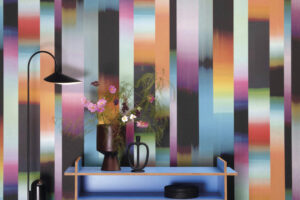
When it comes to interior design, patterns and textures play a crucial role in creating a visually interesting and dynamic space. Mixing different patterns and textures can add depth and personality to a room, making it more visually appealing. However, it can also be a challenging task to achieve a cohesive and balanced look. In this blog post, we will explore the art of mixing patterns and textures in interior design and provide you with some tips to help you create a harmonious and stylish space.
Understanding Patterns and Textures
Before we dive into the tips, it’s important to understand the difference between patterns and textures in interior design. Patterns refer to the repeated design elements, such as stripes, florals, geometric shapes, or plaids. Textures, on the other hand, refer to the way a surface feels or appears to the touch, such as smooth, rough, soft, or shiny. By combining different patterns and textures, you can create a visually stimulating and multidimensional space.
Choosing a Color Scheme
When mixing patterns and textures, it’s essential to start with a cohesive color scheme. A well-thought-out color palette will help tie different patterns and textures together and create a harmonious look. Consider choosing a main color and then incorporating different shades and tones of that color throughout the space. For example, if you opt for a neutral color scheme, you can mix patterns and textures in various shades of beige, gray, or white. Alternatively, you can choose a bold color scheme and mix complementary or contrasting patterns and textures for a more vibrant look.
Creating a Focal Point
One way to effectively mix patterns and textures is by creating a focal point in the room. Choose one element, such as a statement piece of furniture, a vibrant patterned rug, or a textured accent wall, to anchor the space. Let this focal point guide your choices for the rest of the patterns and textures in the room. By having a focal point, you create a sense of balance and unity, allowing other patterns and textures to complement rather than compete with each other.
Consider Scale and Proportion
When mixing patterns and textures, it’s important to consider the scale and proportion of each element. Mixing patterns of different scales can add visual interest and variety to a space. For example, you can pair a large-scale floral wallpaper with smaller geometric patterns on throw pillows or curtains. Just make sure the patterns and textures are balanced and don’t overwhelm the overall design. Similarly, consider the proportions of furniture and accessories when choosing textures. Mixing smooth and shiny surfaces with rough or textured materials can create a visually pleasing contrast.
Layering Textures
Layering textures is another effective way to mix patterns and textures in interior design. By combining different materials, such as wood, metal, glass, and fabric, you can create a rich and visually appealing space. For example, pair a plush velvet sofa with a sleek glass coffee table or mix a rustic wooden dining table with metal chairs. Layering textures adds depth and dimension to a room, making it more inviting and cozy.
Maintaining a Cohesive Theme
While it’s important to experiment with patterns and textures, it’s equally crucial to maintain a cohesive theme throughout the space. Make sure there is a sense of unity in terms of style, color palette, or overall aesthetic. For example, if you opt for a bohemian theme, mix patterns like ikat, paisley, or tribal prints with natural textures like rattan or jute. If you prefer a modern and minimalist look, opt for clean lines, monochromatic color schemes, and subtle patterns.
Playing with Proportions
Mixing patterns and textures allows you to play with proportions and create a sense of balance in a room. If you have a dominant pattern, balance it out with smaller, less intrusive patterns or textures. For example, if you choose a bold floral print for your curtains, balance it out with a subtle striped or geometric pattern on the sofa or pillows. By carefully considering the scale and proportions of each pattern and texture, you can create a cohesive and visually pleasing design.
Incorporating Neutral Elements
If you’re hesitant about mixing too many patterns and textures, incorporating neutral elements can help create a sense of calm and balance. A neutral backdrop, such as a neutral-colored wall or flooring, can serve as a canvas for mixing patterns and textures. Additionally, choose a neutral pattern, such as a classic striped or herringbone pattern, to anchor the design. This will allow other patterns and textures to shine and prevent the space from feeling overwhelming.
Summary
Mixing patterns and textures in interior design requires careful consideration and experimentation. By understanding the difference between patterns and textures, choosing a cohesive color scheme, creating a focal point, considering scale and proportion, layering textures, maintaining a cohesive theme, playing with proportions, and incorporating neutral elements, you can create a visually interesting and harmonious space that reflects your personal style and creativity. Remember, there are no hard and fast rules when it comes to mixing patterns and textures – let your imagination guide you and have fun with the process!



Leave a Reply